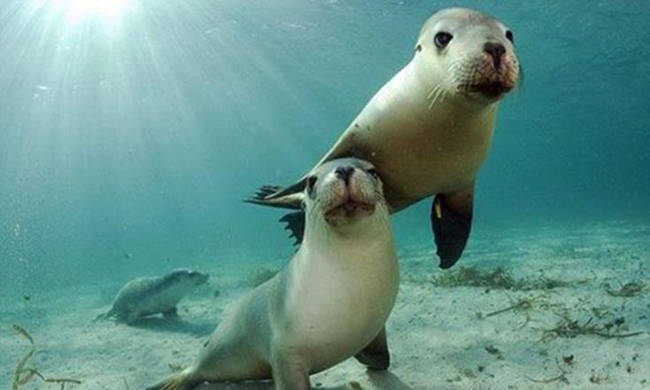N.E.C.C.A. aims to ensure the sustainable development of biological resources, in a rational management base, to promote the preservation of populations and biotopes. Biological Resource Management deals with the interaction and conflicts derived from human impacts on wild life and the natural environment.
Targets of Biological Resources Management:
There are three main directions of Biological Resources Management plan:
- Increase Populations
- Constant Population Removal in such a way to determine the stability of a steady state
- Maintain populations in a decreased or steady state
The sea turtle species Caretta – caretta
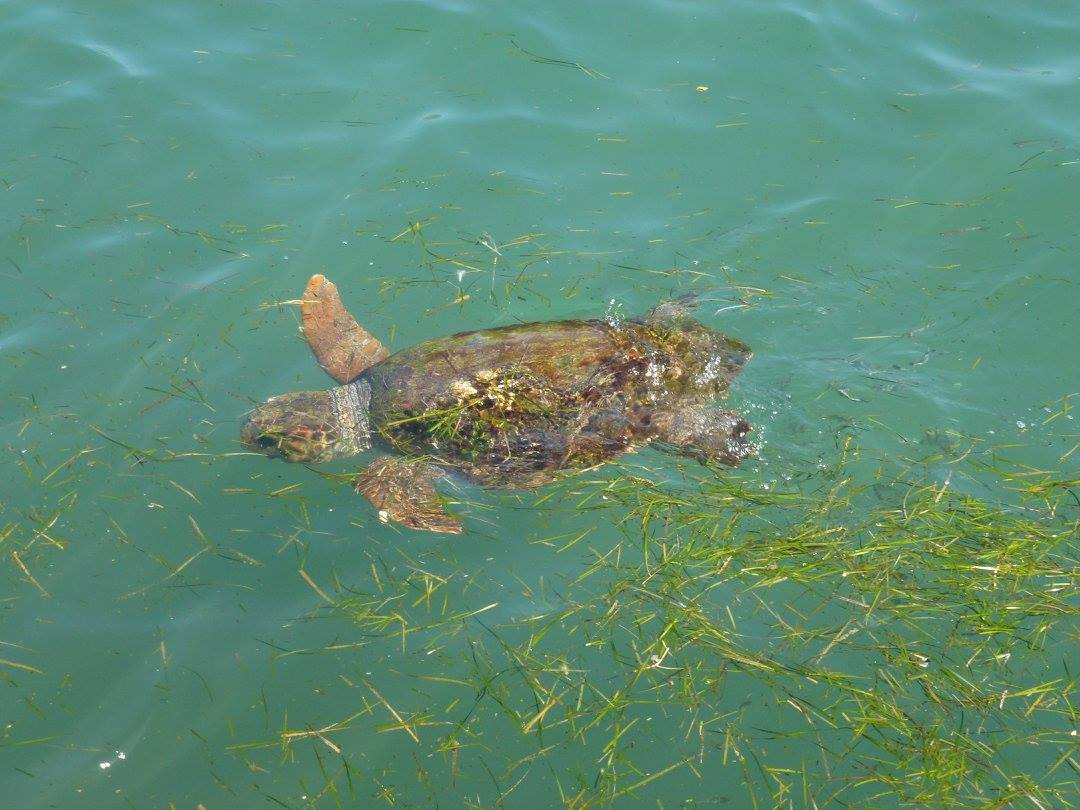
47% of the nesting beaches of sea turtle Caretta caretta in the Mediterranean are located in Greece. This species is easily distinguished from the others because of turtle logger head, reddish-brown shell and yellow-brown skin. Sea turtles always return to the exact same beach where they were born to deposit their eggs. This means that human activities destroying beaches or preventing sea turtles from emerging may cause serious weakness in sea turtles reproduction. For this reason, it is very important to consider all the conditions necessary to preserve the nests and ensure the survival of this endangered species.
Nesting beaches in Greece are located in Zakynthos (Laganas Bay), Kefalonia (Mounta Bay, Megali Ammos, Minies, Ammes, Makris Gialos in Lassi and Mega Lakkos in Lixouri), Peloponnese and Crete. The incubation period ranges from June to August, when female emerges from seawater to deposit her eggs. First, the sea turtle explores the beach ground searching for a good quality nesting habitat above the high water mark with suitable quality of sand and temperature. As soon as the turtle finds a spot, it digs a nest in the sand at a depth of about 50 centimeters, by using her back flippers, to successfully deposit about 120 small and soft eggs, 60% of which will hatch in about 50 days. When the tiny turtles hatch out, they are directed towards the sea, following the horizon and the reflection of the moonlight. Because of light pollution from beach bars and restaurants provoking disorientation, physical obstacles found on the way to the seawater and multiplus coastal and marine predators, just one in a thousand tiny turtles will ever survive to become adult. For this reason, sea turtle Caretta caretta, one of the oldest species in the world, is registered as an endangered species from extinction on the International Union for Conservation of Nature's Red List of Threatened Species (IUCN) and definitely needs our help and support for its conservation!
The Mediterranean Seal (Monachus monachus)
The Mediterranean Seal (Monachus monachus) belongs to the Family of Phocidae and got its name from its characteristic skin lump behind its head that makes it looks like a monks’ hood. Some ancient Greek coins depict seals and excerpts from Homer’s Odyssey describe them enjoy beach time undisturbed proving that in antiquity people had a good consideration of this marine mammal. Actually, the name of the sea monk was given to two ancient cities: Fokaia located in Attica and its colony city in Asia Minor. Till the 15th century monk seal population was widely and continuously distributed in the entire Mediterranean, the coasts of Atlantic Ocean and the Black Sea. Afterwards it had been caught for commercial exploitation and subsistence because considered strong competitor to fisheries resources so that today the Mediterranean monk seal is among the most endangered species from extinction in Europe. Today 500 monk seals Monachus monachus have remained, with a size of up to 2-3 meters, weighing 250 kilos and strictly distributed to the coasts of Aegean and Ionian Sea, Morocco and Mauritania. Seal’s skin is covered by glossy commonly colored grey or brown fur on the back and lightly colored belly. Newly born seals are one meter long and weigh 15-20 kilos. Their skin is entirely covered by long black fur with a white patch on the belly. Monk seals feed on a wide variety of fish as well as polyps, calamari, etc. They travel long distances in search of food up to 5% of seal’s weight. They are remarkably intelligent, curious and easily adaptable. Even if seal is a mammal, special type of muscles allow to hold its breath underwater for 15 minutes with its nostrils completely closed. Females reach maturity earlier than the males, at the age of 3 - 4 years old; their life cycle is from 30 to 45 years. Every two years from May to November, the seal enters in a slow reproductive cycle of 12 months, (10 months of pregnancy and 6 – 8 weeks of nursing). The period from pregnancy to the age of three months, is the most vulnerable for the seal. When in a group, in case of disturbance inside the sea caves, seals may panic and rush off hastily, provoking miscarriage or injuries to newly born that do not move quickly or swim properly.
To prevent Monachus monachus extinction, we should seriously consider its threats that comprise pollution, marine litter, overfishing and their killing from fishermen. Chased by man commercially for its oil and skin, monk seal finds refuge to coasts and rocky islands, away from humans, its biggest enemy, who acts only on his own interest. Usually, hunting takes place during the breeding season, when seals spend a lot of time offshore, and for this reason it is very difficult to escape. On the other hand, there are some ecological organizations aware of the problem, trying to inhibit seal extinction. Unfortunately their efforts are not enough to solve the problem. The Mediterranean seal Monachus monachus is found on a high position in the ecological pyramid to be considered as an index of a healthy marine environment and for this reason its protection should be an imperative need.
Dolphins thriving in the Marine Protected Areas of Kefalonia and Ithaca
Dolphins are known to be among the most popular and intelligent animals to humans for their playful and friendly behavior. Name dolphin derives from the ancient Greek word “δελφύς” (uterus) denoting the uterus of the marine mammal. In the Greek Seas there have been recorded as many as 9 different species of dolphins. Species observed often include the bottlenose dolphin, the common dolphin, the striped dolphin and the Risso’s dolphin. Less frequently are detected the rough-toothed dolphin, the long-finned pilot whale, the false orca, and the orca (mistakenly called killer whales). In the protected areas of Kefalonia and Ithaca dolphins most frequently seen are the common dolphin and the bottlenose dolphin.
The bottlenose dolphin (Tursiops truncatus)
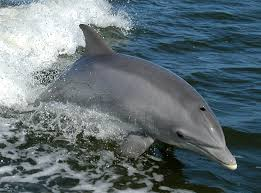
Bottlenose dolphins are characterized by a rather short thick beak and represent one of the largest members of Delphinidae Family (subclass Odontoceti). They can be confused with large size Risso’s dolphins (Grampus griseus sp.) as they both have tall dorsal fins and can move powerfully with great intention. The dorsal fin, which is large, tall, and turned to one side, is located in the middle of dolphin’s back. The side wings are medium thin and become darker at the ends. It is colored rather uniformly without great variations, mostly dark on the back (light grey to almost black) and white or pink ventrally. Some bottlenose dolphins may present a light colored area extending from the upper part of the lateral to the dorsal fin. Each side of bottlenose dolphins’ jaw houses 36 to 54 sharp teeth. Dolphins’ size ranges from 1,9 to 4,1 meters in length, depending on the location they thrive because varies inversely to the water’s temperature. Males are typically larger than females, and in Greece a maximum length of 3,3 meters for males and 3,2 meters for females has been recorded.
Features for Tursiops truncatus sp. identification:
- Compact and massive body and head with a sharp crease between the short beak and the melon (forehead)
- Color varying from dark grey on the back to lighter grey on the flanks and almost white ventrally, without intensive skin ridges
- Tall and curved dorsal fin, located close to the center of dolphin’s back
- Long pectoral fins with pointed tips
- Tail fins with pointed tips
- Highly active, swim and play alongside boats
- Group in pods and share their ocean habitats with other cetaceans.
- It is the 2nd largest dolphin species encountered in Greek Seas after Grampus griseus sp.
CONSERVATION REGIME IN THE MEDITERRANEAN SEA: this species is classified as Vulnerable (VU) in the IUCN Red List of threatened species.
The common dolphin (Delphinus delphis)
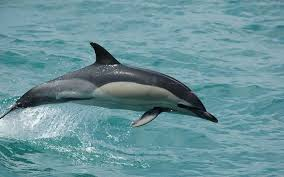
The dolphins of this species are shorter in length than the bottlenose dolphins (about 1,80 meters) and excellent swimmers because of their hydrodynamic shape, able to cover large distances in a short period of time by reaching speeds of over 60km/hr. Their diet consists of many species of fish (piscivores) like anchovy, sardines, squids etc. This species can be easily identified by a distinctive colour pattern referred to as “hourglass” because of a dark grey cape extending along the back from the head to the dorsal fin, ahead of which, behind the head, there is a yellow tan panel in contrast with the dark back, and the side of the body that is lightly grey. The coloration pattern may differ between juveniles and adults or populations in distant geographic areas. Even if it is not known exactly the current size of Delphinus delphis in the Greek Seas, it is common knowledge that its population declined sharply in the last 30-40 years in the Greek area, and for this reason is comprised in the Greek Red Data Book of threatened fauna (Zoological Museum, National and Kapodistrian University of Athens, 2009). It has been reported that common dolphins have a pronounced seasonality of reproduction, with conception occurring every 2-3 years and parturition period of 10-11 months, while their lifespan is unknown. There have been recorded two different phenotypes of these dolphins in the area: the short-beaked common dolphin thriving in the pelagic zone and the long-beaked common dolphin living in neritic habitats. Except of the short length of the beak, pelagic dolphins are brighter colored than the neritic ones, with a brighter black patch around the eyes, a more rounded head, and a narrower band between the lower jaw and the fins.
The long-beaked common dolphins live in depths up to 200 meters and close to the coastline of northern and central Ionian Sea, the Saronic, Corinthian, north Evoikos, Thermaic and Pagasitikos Gulfs, the Archipelago of Cyclades and Dodecanese and the Thracean Sea, where common dolphins have been most frequently recorded. A noteworthy and unique feature of common dolphins thriving in the Corinthian Gulf is their living in mixt groups with Risso’s and stripted dolphins. Their population is threatened by reduction of food availability, fishing activities (deliberate killing or fishery bycatch) and contamination resulting from man-made chemicals.
Pinna nobilis
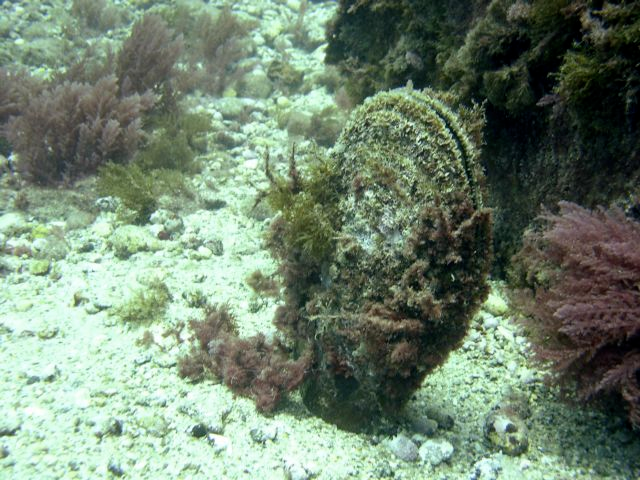
The sessile bivalve Pinna nobilis is a filter-feeding organism playing an important role on the maintenance of seawater quality. It is an endemic species to the Mediterranean Sea, with life cycle of 20 years. Pinna nobilis thrives at depths from 0,5 to 60 meters, close by or in association with beds of the marine angiosperms Posidonia oceanica and Cymodocea nodosa. Pinna nobilis occupies habitats of seawater purity, efficiency of sunlight, low seasonal salinity variation (3,4 - 4%), moderate temperature (7 to 28°C) and uniformly slow flow of seawater containing enough nutrients. It spawns once a year for a few weeks at the end of the summer. The main threat for Pinna nobilis is the illegal fishing and the destruction of its habitat due to anchoring and fishing by using illegally sliding tools. This pen shell is the largest bivalve mollusc of the Mediterranean Sea. Lately, it has been recorded in the Greek Seas the presence of the parasite Haplosporidum pinnae that threatens Pinna nobilis with extinction. This parasite first appeared on the Spanish coastline in 2016 and since then it has provoked extensive mortality to P. nobilis populations. The devastating results of parasite’s action are now visible also in the marine habitats of Kefalonia and Ithaca islands. Pinna nobilis is protected by the European Directive on Ecotopes 92/43, Barcelona Convention and the Greek legislation.
Posidonia oceanica
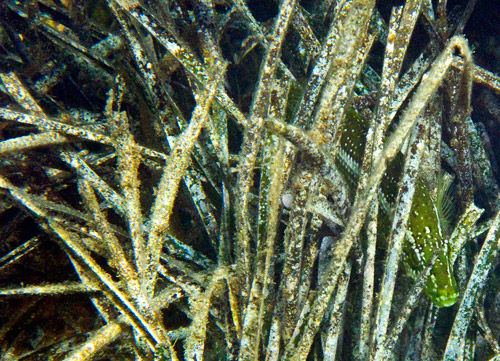
The Genus of Posidonia comprises monocotyledon marine flower plants (angiosperms) that grow on a soft substratum. Posidonia oceanica species grows in large dense meadows covering the sea floor of the Mediterranean Sea and the southern and western Australian coasts. Posidonia meadows are considered of great environmental value and are recorded at depths from 1 to 35 meters. Its floating fruits in Italy are called “sea olives”. The plant stability is achieved by roots and rhizomes underground, with ribbon-like, green parallel-veined foliage leaves, up to 1,5 meters long, appearing in tufts of 6 or 7. Initially, the color of its leaves is light green, but turns brown with age. Posidonia oceanica main threats derive from human activities like drifting bottom nets, and infrastructure constructions along the Mediterranean coastline that increase the quantity of sediment transported to the sea, and the water turbidity. As a result, the sunlight reaching the bottom of the sea is reduced and transported sediment covers Posidonia leaves. Another important major threat for Posidonia oceanica derives from two alien algae species, Caulerpa racemosa and Caulerpa taxifolia that invaded in the Mediterranean and since then occupy the space of Posidonia oceanica. According to the Water Framework Directive, the ecological state of water bodies is evaluated in basis of qualitative biological data. Posidonia oceanica is particularly sensible to pollution, and for this reason it is used as a pollution biotic index, to provide information about the pollution gradient of seawater. Posidonia oceanica absence from an ecosystem may occur before pollution levels and seawater scarce quality are perceived on a large scale. The basic criteria to keep under consideration, and choose properly a biotic index, comprise the sensibility against stress, the ability to provide complex information in a reliable way, the easiness of specification, structure simplicity, abundance, and applicability to extensive geographical areas.
Cetaceans
Sperm whale (Physeter macrocephalus)
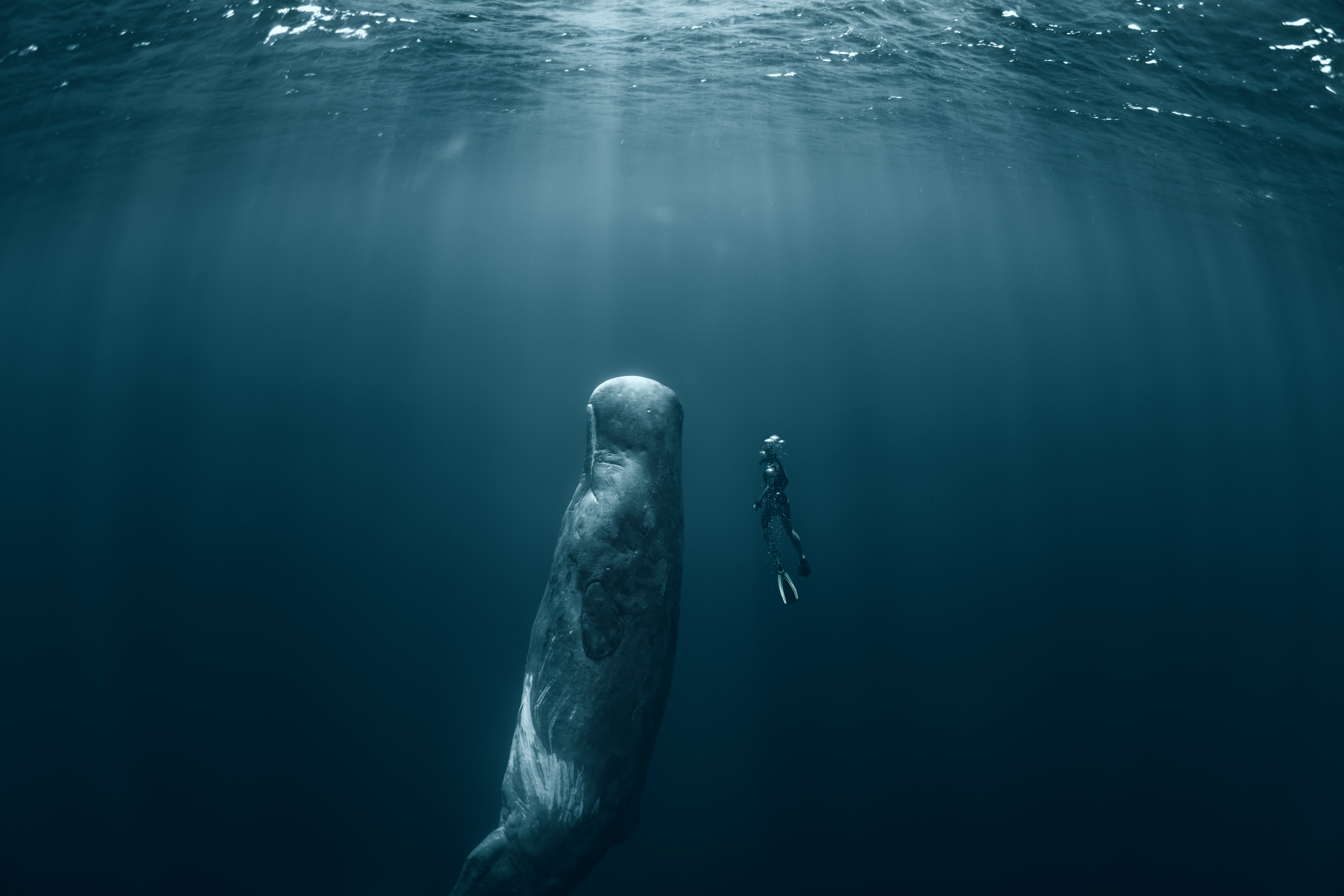
How many people know that the species with the largest brain ever recorded in the animal kingdom and third biggest sized animal in our planet, lives in the Greek Seas? Sperm whale impress not only because of its size, but also for its social behavior, the infallible bio-sonar system used for orientation and foraging and its excellent diving capacity. In Greek waters the sperm whale thrives along the Hellenic Trench (extending from the western Ionian Islands and Peloponnese to the south of Crete and south-east of Rhodes), in the Myrtoon Sea and elsewhere in the Aegean. Its population reaches 300 individuals. When on the surface, swims in a relaxing rate of 7km/h, but it is able to reach 2000 meters depth with just one breath, and remain to the sea floor for up to one and a half hour.
When giving birth, the entire group helps and protects the future mother; these sperm whale groups are big families including adult females with calves and juvenile males and females. Crashing with boats may be considered the main threat for sperm whales, followed by military exercises, oil and gas research, the accidental trapping during fishing activities and the ingestion of solid waste. When they swallow plastic bugs mistaken for food, their digestive system is blocked and as a result they die in horrible pain. Prolonged or chronic exposure to sounds may cause hearing loss, and sleeping vertically may bring to fatal collisions with boats.
Features for Physeter macrocephalus sp. identification:
- Giant head
- Jets water on the left at a 45° with water surface
- Short hump instead of a dorsal fin, followed by a series of crenulations along the dorsal ridge.
- Each half of the tail forms a right triangular with a deep V shaped notch
- They have a dark body and a wrinkled skin
- Sperm whale usually floats on the surface, but it also performs spectacular jumps almost entirely out of the water
- It forms groups of 3 to 7 individuals
Phocoena phocoena
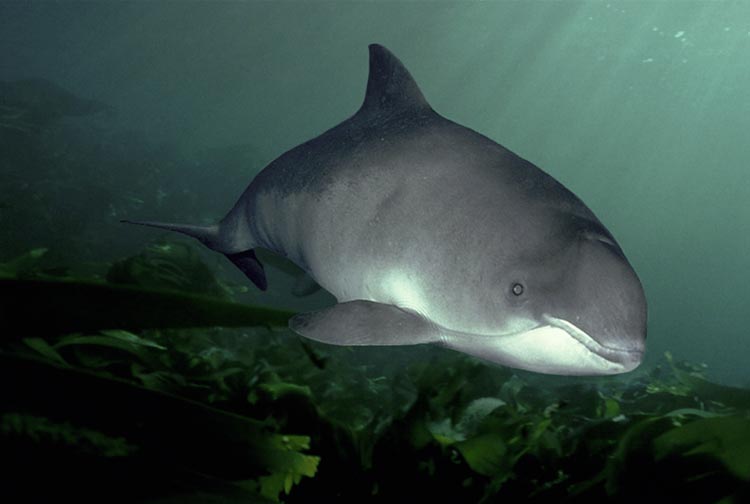
Phocoena phocoena is one of the smallest cetaceans in size, of 1,4 meters in length. It is characterized as a “shy” odontoceta, a very rare mammal which has been recorded in the north Aegean Sea only 4 times in the last 20 years. This fact is very important, as it has been recorded in the Mediterranean 5 times in total to be considered extinct since last century and maybe this is the reason of not been comprised in the Red List of the threatened species (already considered extinct). Phocoena phocoena population living in the Thracean and North Aegean Sea is considered the only population remained in the Mediterranean. The scientific name Phocoena phocoena derives from ancient Greek word “focaena” used by Aristoteles who recorded this marine mammal and took notes about it. It lives up to 24 years and dives up to 41 meters depth. It usually lives in groups of 2 to 10 individuals, but not when it goes hunting, despite most dolphin species. Except their small size compared to dolphins, they also lack of dolphins’ distinct snout and the triangular dorsal fin.
Features for Phocoena phocoena sp. identification:
- Scales scratched to the back of the dorsal fin
- Scarfs on the dorsal fin or at the posterior part of the body
Like all the other cetaceans Phocoena phocoena is threatened by operations in petroleum exploration, noise pollution, climate change, conduction of military exercises, and pleasure crafts nuisance and disturbance. In addition, by living close to the coastline, Phocoena phocoena becomes vulnerable to threats related to fishing activities, and risks to get injured or accidentally trapped to fishing gears. Another threat for this cetacean is the reduction of food resources. More details about Phocoena phocoena presence in the Greek Seas were shown in 1998 documentary of exceptional interest “Phocaenas in the north Aegean”, funded by the International Funding for Animal Protection (IFAW).
Cuvier's Beaked Whale (Ziphius cavirostris)
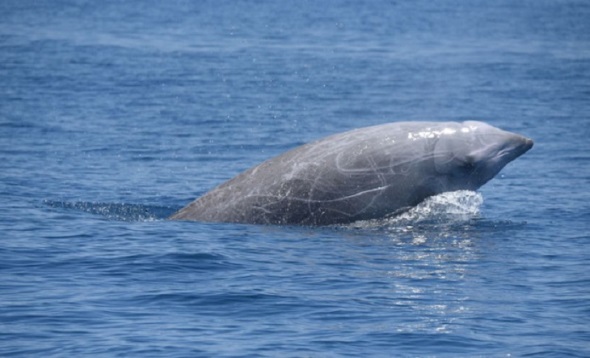
Cuvier's Beaked Whale is an inaccessible and one of the best cetacean divers, reaching more than 2000 meters depth. Ziphius cavirostris lives in the same area of sperm whale’s habitat. Individuals of this species are recorded in north Crete and western Lefkas along steep slopes with a sharp depth gradient. It is bigger than dolphins (5 meters in length) and feeds almost exclusively of squids. In Greece, 50% of the cases recorded were single individuals, 40% couples, and 10% groups of 3-5 individuals. Cuvier's Beaked Whale is a cosmopolitan cetacean, except the Mediterranean it may live in any other sea around the world.
It has a long compact body that is characteristic of Ziphiidae family, with a not distinguishable curved beak; the melon is not distinguishable as well, and in adult males it may be bigger in size. Cuvier's Beaked Whale has two deep V-shaped throat grooves. It also presents a slight cavity at the top of its head, usually seen in older individuals. The short length dorsal fin moves both directions, and is located quite in the back. The tail is quite big and there is not always a central notch. It has rather small fins, and hidden in lateral curves like pockets, to achieve a high performance of hydrodynamic swimming. Cuvier's Beaked Whale may be the cetacean with the widest color variety from dark grey (especially in adult males) to reddish brown (especially in females), with light color hues, around the head and abdomen. Adult males head and a part of their back may be totally white. The surrounding of their eyes is dark colored. Older individuals present scratches, round holes that may be due to the attack of small sharks.
Other important marine protected species
Petromizum marinus
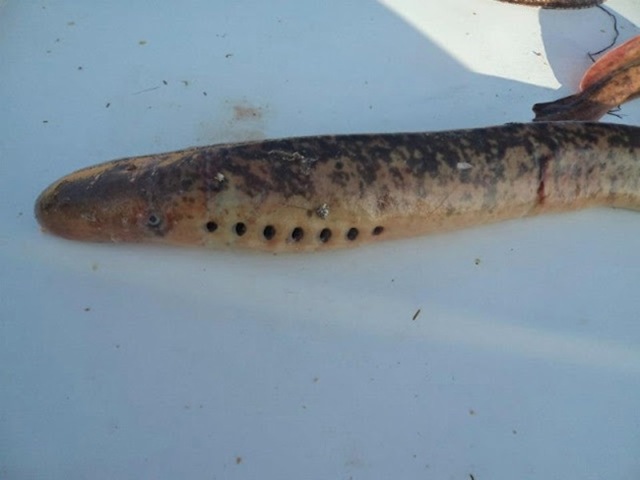
Petromizum marinus also called lamprey is a jawless fish (Agnathan) with a soft cartilaginous skeleton. This fish is among the most primitive of all vertebrate species classified into the subphylum Vertebrata with long tubular bodies, to be usually mistaken with eels. In each part of their head there is a visible eye point, located behind a single nostril and in front of a distinctive row of a 7 pairs set of gill openings. While attacking the host, their disc-shaped suction-cup mouth becomes bigger in size than both head and pharynx. The mouth is ringed with sharp and horny teeth pointing inwards. Sea lampreys have two separated dorsal fins when young; these fins migrate closer when sea lampreys become adults, while they lack of paired fins. During spawning, it takes place the development of a distinct ridge along males’ back and a pronounced fold of skin behind females’ vent. Sea lampreys are the largest and most aggressive among lamprey species. There are some key differences between the juveniles and adults (weighing up to 2.5 kg): juveniles’ length size ranges from 15.2 to 30 cm, while adults size varies from 30 to 100 cm. The larvae are generally colored dark greenish brown and light grey underbelly; the adults are brownish grey and become more lightened when about to spawn.
